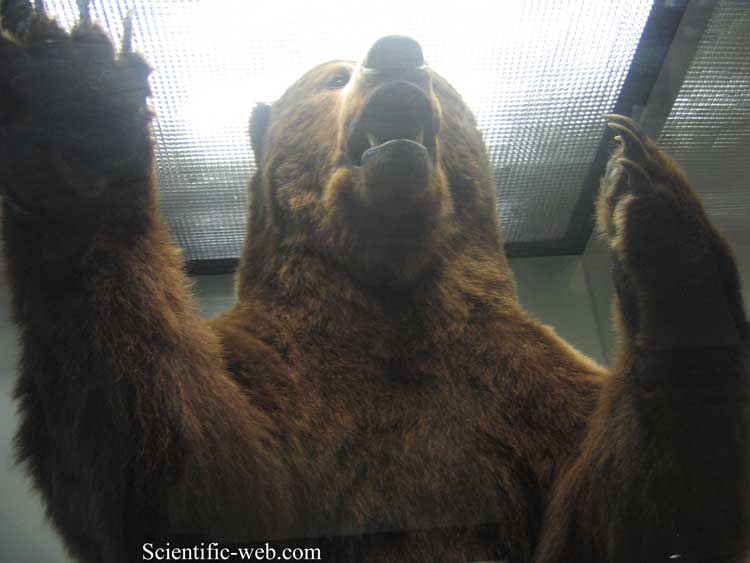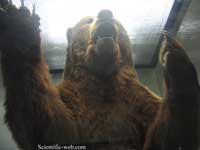Superregnum: Eukaryota
Regnum: Animalia
Subregnum: Eumetazoa
Cladus: Bilateria
Cladus: Nephrozoa
Superphylum: Deuterostomia
Phylum: Chordata
Cladus: Craniata
Subphylum: Vertebrata
Infraphylum: Gnathostomata
Superclassis: Tetrapoda
Cladus: Reptiliomorpha
Cladus: Amniota
Cladus: Synapsida
Cladus: Eupelycosauria
Cladus: Sphenacodontia
Cladus: Sphenacodontoidea
OrdoTherapsida
Cladus: Theriodontia
Subordo: Cynodontia
Cladus: Mammaliaformes
Classis: Mammalia
Subclassis: Trechnotheria
Infraclassis: Zatheria
Supercohort: Theria
Cohort: Eutheria
Cohort: Placentalia
Cladus: Boreoeutheria
Superordo: Laurasiatheria
Cladus: Ferae
Ordo: Carnivora
Subordo: Caniformia
Familia: Ursidae
Genus: Ursus
Species: Ursus arctos
Subspecies: Ursus arctos beringianus
Name
Vernacular names
Deutsch: Kamtschatkabär
Türkçe: Kamçatka boz ayısı
The Kamchatka brown bear (Ursus arctos beringianus), also known as the "Far Eastern brown bear", or in Russian: Камчатский бурый медведь, romanized: Kamchatsky bury medved, is a subspecies of brown bear.
Description
Captive bear with cub at Tierpark Hagenbeck, Germany
The Kamchatka brown bear is the biggest brown bear in Eurasia,[1] with a body length of 2.4 m (7.9 ft) to 3 m (9.8 ft) tall on hind legs, and a weight up to at least 650 kg (1,430 lb).[2] It is nearly the size of the Kodiak bear; however, the skull is broader than that of the Ussuri brown bear,[3] and compared to that of the Kodiak bear, the breadth of the skull is much greater in proportion to its length, the anterior narial opening is much shorter, and the molars differ in relative size and form.[4] The greatest skull length for males is 40.3–43.6 cm (15.9–17.2 in), and they are 25.8–27.7 cm (10.2–10.9 in) wide, while the skulls of females measure 37.2–38.6 cm (14.6–15.2 in) in length and 21.6–24.2 cm (8.5–9.5 in) in width. Fur colour is predominantly dark brown with a violet tint. Light coloured individuals are rarely encountered.[2]
Distribution
It is native to the Anadyrsky District, the Kamchatka Peninsula, Karaginskiy Island, the Kuril Islands, the coastal strip west of the Sea of Okhotsk southward to the Stanovoy Range, and the Shantar Islands in the Far East. Outside the former Soviet Union, the subspecies occurs in Saint Lawrence Island in the Bering sea.[2] It is closely related to one clade of brown bears in Alaska and northwest North America, and is thought to be the ancestor of the Kodiak bear.[3]
Behaviour and ecology
Bear near Dvuhyurtochnoe Lake
In the summer period they feed on blueberries, crowberries, humpback salmon, and steelhead. In autumn, they eat nuts from nut-pines and mountain ash, and fish. In times of famine they eat dead fish or marine mammals, berries, and graminoid vegetation.[2]
Relationship with humans
Bear passing by people at Kurile Lake
Kamchatka brown bears are generally not dangerous to humans, and only 1% of encounters result in attack.[5] The first Europeans who went to Kamchatka in the 19th century, although surprised by the number and size of bears there, observed that they were relatively harmless, compared to their Siberian counterparts.[6] However, in July 2008, a platinum-mining compound in the Olyutorsky District of Kamchatka Krai was besieged by a group of 30 starving bears who killed two guards.[7]
Trophy hunting
Kamchatka brown bears are among the most prized trophies for the Russian hunting industry. In 2005 the Kamchatka Department of Wildlife Management issued 500 hunting permits. Clients paid up to $10,000 to hunt bears. Thus, the economic impacts from recreational hunting of Kamchatka brown bears are significant.[1]
References
John Snyder; Bernard Stonehouse, eds. (2007). Prospects for polar tourism. CABI. ISBN 1-84593-247-1.
V. G. Heptner; N. P. Naumov, eds. (1998). Mlekopitajuščie Sovetskogo Soiuza. Moskva: Vysšaia Škola [Mammals of the Soviet Union, Volume II, Part 1a, Sirenia and Carnivora (Sea cows; Wolves and Bears)]. Vol. II, Part 1a. Washington, D.C., USA: Science Publishers, Inc. ISBN 1-886106-81-9.
McLellan, B. N.; Reiner, D. (1994), A review of bear evolution (pdf), vol. 9, International Conference Bear Res. and Management, pp. 85–96, retrieved 2011-09-26
Robert Rausch, On The Status Of Some Arctic Mammals (pdf), retrieved 2011-09-26
Revenko, I. A. (1994), Brown bear (Ursus arctos piscator) reaction to humans on Kamchatka (pdf), vol. 9, Petropavlovsk-Kamchatskiy, 683024, Russia: Kamchatka Ecology and Environmental Institute, pr. Rybakov, 19 a, pp. 107–108, retrieved 2011-09-26
"The Kamchatka Brown Bear". Kamchatkapeninsula.com. Retrieved 2011-09-26.
Harding, Luke (2008-07-23). "Bears eat two workers in remote Russian region". The Guardian. ISSN 0261-3077. Retrieved 2020-06-10.
Retrieved from "http://en.wikipedia.org/"
All text is available under the terms of the GNU Free Documentation License




